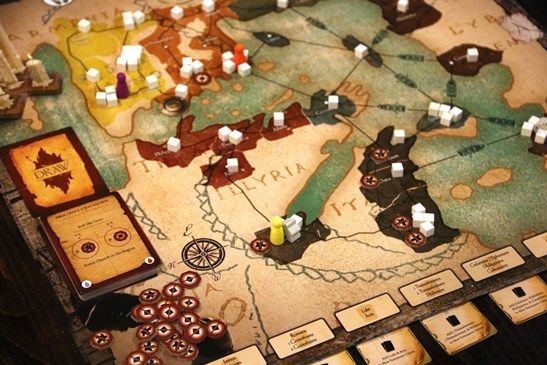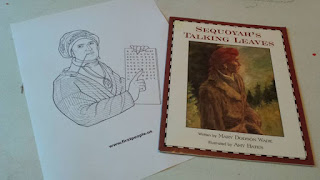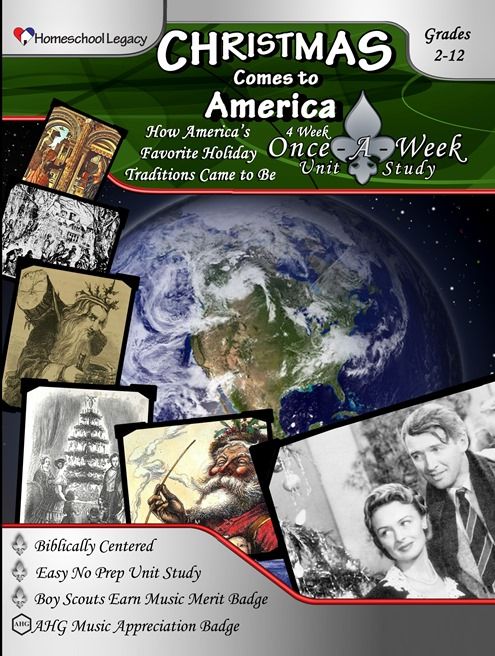
We received the Commissioned board game from Chara Games to review. This was a game that originally started on Kickstarter and is now available at online retailers and possibly your LFGS (local friendly game store). Commissioned was designed by Patrick and Katherine Lysaght, who are also the founders of Chara Games. Commissioned is their first game that they designed and published together. They also have a second game coming out, that was recently on Kickstarter, called 3 Seeds. They did not design the game, but they published it. Chara Games is new to publishing games, but from the comments I have read on Kickstarter and from other board game reviewers, they produced a high quality game and even got it out to backers before the expected delivery date.

Commissioned is for 2-6 players, ages 14+ (recommended age, but younger players can certainly learn how to play if they are experienced gamers), and plays in about an hour. We played our first game in just over an hour, but the first "learning game" typically take extra time. With more players, it will likely be 60-90 minutes. There are multiple missions that you can play, so I expect play times will vary.

Commissioned is a game where you play the Apostles in the early days of Christianity. You and the other Apostles are traveling around trying to spread the word of God and build churches in cities across the map. In the first scenario we needed to have one follower in each city and all of the books completed. On each turn you also have to play a threat card, and in our first game we got the three worst cards back to back at the start of the game. It really set us back and made the rest of the game much harder. We did fail the first game, but came really close. With one more turn we might have won. We actually don't mind playing games where we lose, but I can imagine younger players would be upset by that. However, it's a neat part of the game because it's based on historical events.

The Commissioned board game comes with a rule book and a theme appendix. This is especially helpful if you plan to use this game to teach about Christianity. I think it would be a really interesting game to have at church, on church group trips, Bible camp, etc. It could also be used in a theology classroom.
The board is double-sided and has a linen finish (which is a high quality finish and looks and feels lovely). It is double-sided because you can play with 2-6 players and to keep the game balanced there are larger areas and more locations to cover with the higher player count.
The footprints at the top is where you put the four draw piles. These are cards that you can buy throughout the game. They have different costs and the cards have weaker abilities for the cheaper cards and stronger abilities for the more expensive cards. The candles on the left is where you track when you lose locations or when bad things happen. Snuff out enough of them and you lose the game.
The cards on the left of the board are the threat cards which determine what kind of obstacle you're going to face that turn. Sometimes it's that an Apostle will be imprisoned, sometimes it prevents followers from moving, other times it cuts your flock in half. If you play through that entire deck you also lose.
The book locations at the bottom of the board is where you store the books when you complete them. You simply take the card with the matching book and slip it halfway under the board so that it shows sticking out. The first time we played we did this part wrong. We completed the books and marked it with a white cube, leaving the card in our hand. A few turns in we realized we had been doing it wrong and kept it in mind for the next game. It makes a lot of sense to "spend" the card, because it helps to keep your deck size down.
Here are the components: decks of cards, player cards, first player marker, white follower cubes, meeples, mission cards, cardboard tokens, and Apostle player pieces.
The components are thick cardboard.
I played Barnabas in the first game. I chose him at random, and barely used his special special ability. Each round you draw six cards from your deck, then you choose two to play. You place these face down on your character sheet. Then when everyone is done choosing, you reveal the cards. The person with the first person marker gets to choose which of the actions they want to use. You can discuss which ones would be best to play, unless a card says otherwise. Then you move cubes, player pieces, or spend cards, and the first person marker is handed to the next player. We have only played with two players so far. After two rounds, you have two cards leftover in your hand. These cards have a value on them and that lets you "spend" them on the special cards. These cards can give you special abilities, like clearing obstacles, extra movement, books, get out of jail, etc.
The above picture shows how we played during the first game and explains why we played wrong. We played on the same side of the table, and I had the baby on my lap, so we put the cards at the base of the game so they were easier to reach. It took up the space where we should have been putting the spent book cards.
The goal of the first mission was to complete all of the books and have at least one follower in each of the locations. We managed to complete all of the books, but were four locations short. One more turn would have won us the game, but sometimes you run out of time. We ran through the threat deck, so we did as much as we could manage on the last few turns. We took mental notes and made sure we didn't make the same mistakes on the next play through.
We don't usually buy religious games, but Commissioned was really well received. We loved the quality of the board game and components for its price. We enjoyed the historical side of it and actually learned from the game. We haven't had a chance to play it with our friends yet, but we have a few Christian friends who are looking forward to trying it. They checked it out while they were over and agreed that it looks interesting and unique. We look forward to our next few games of Commissioned!
Look out for our review of 3 Seeds, the newest game from Chara Games, which was recently on Kickstarter.

Be Social
@Charagames
To read more reviews from the TOS Crew, click on the banner below.








































